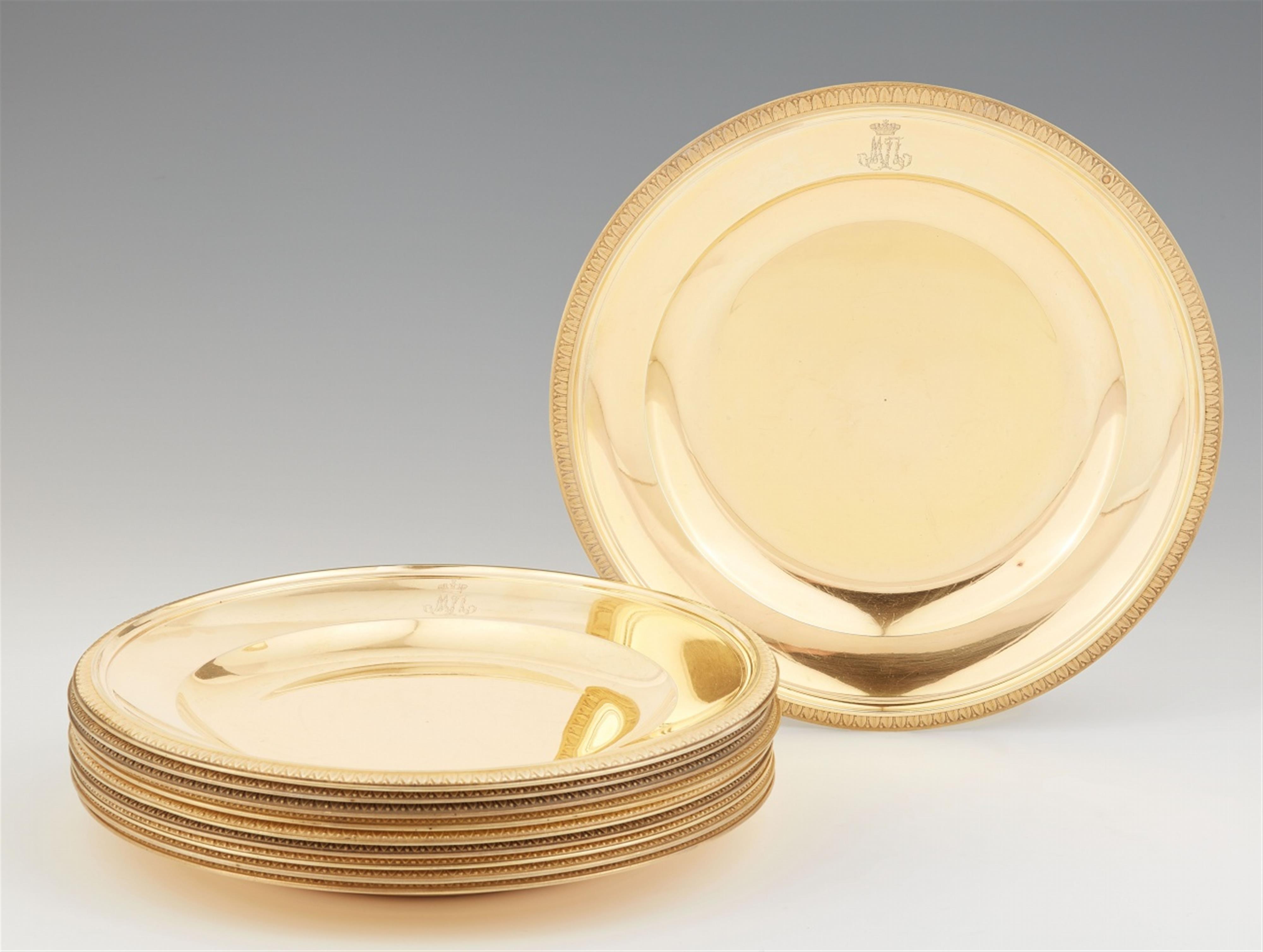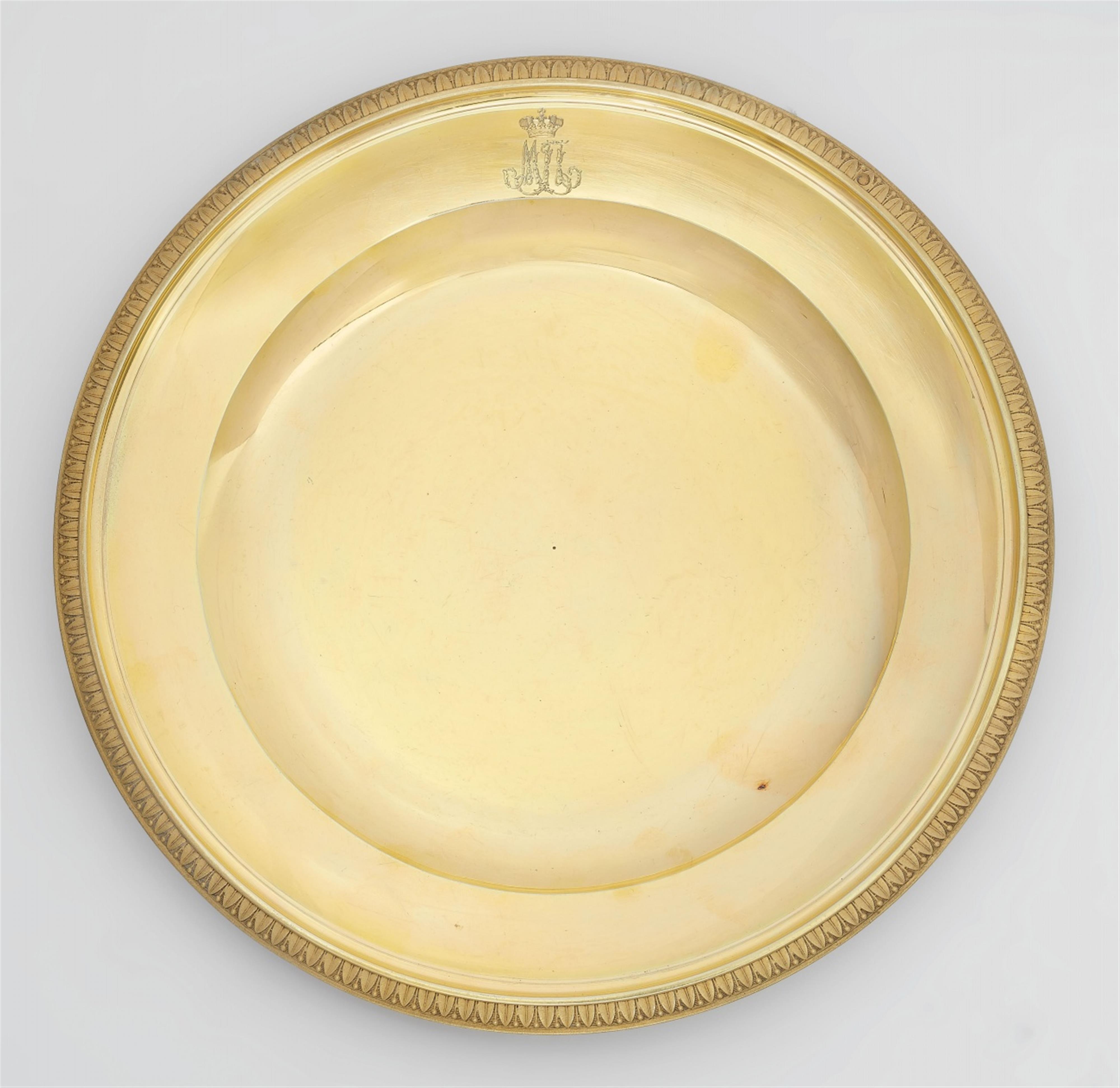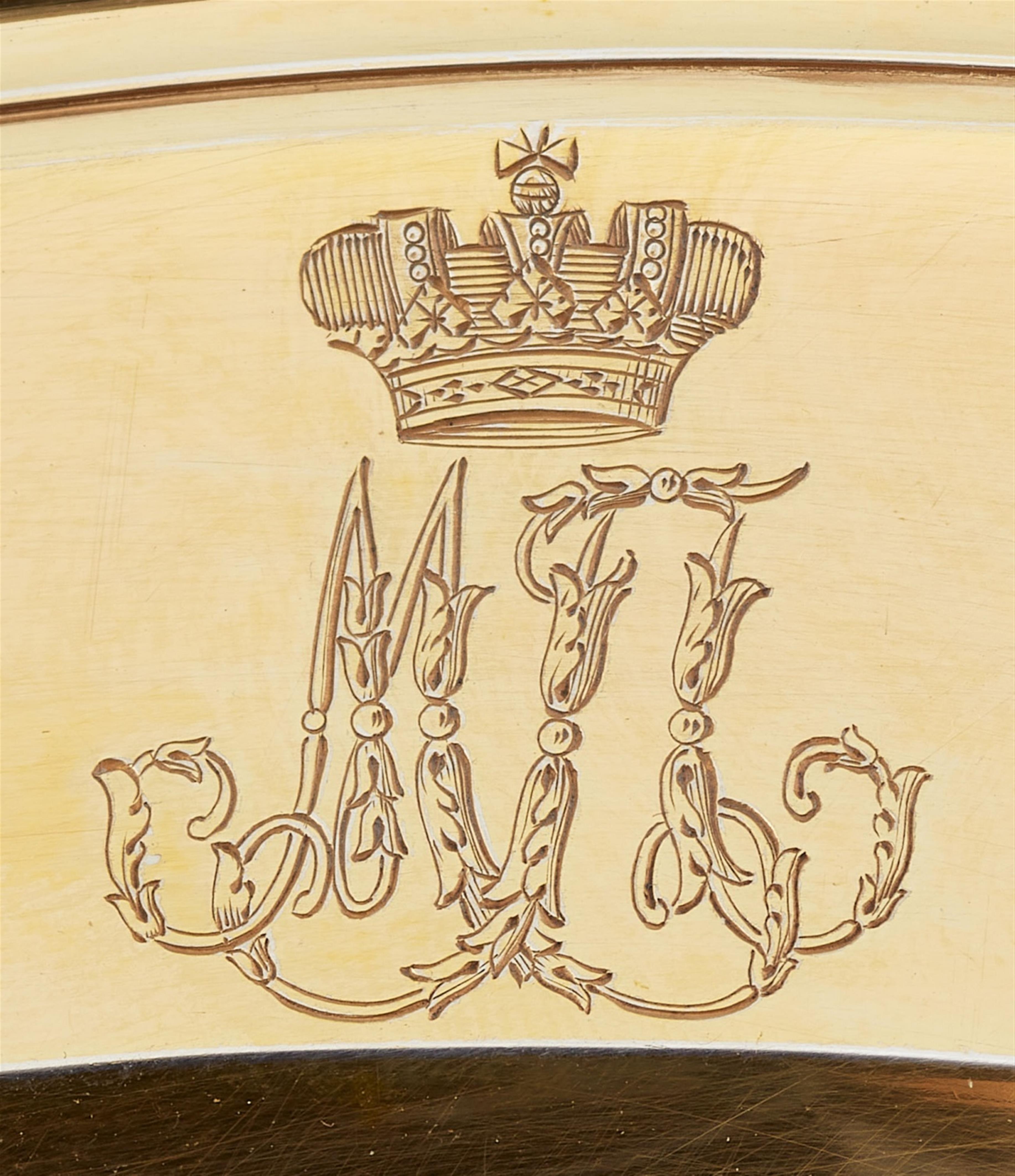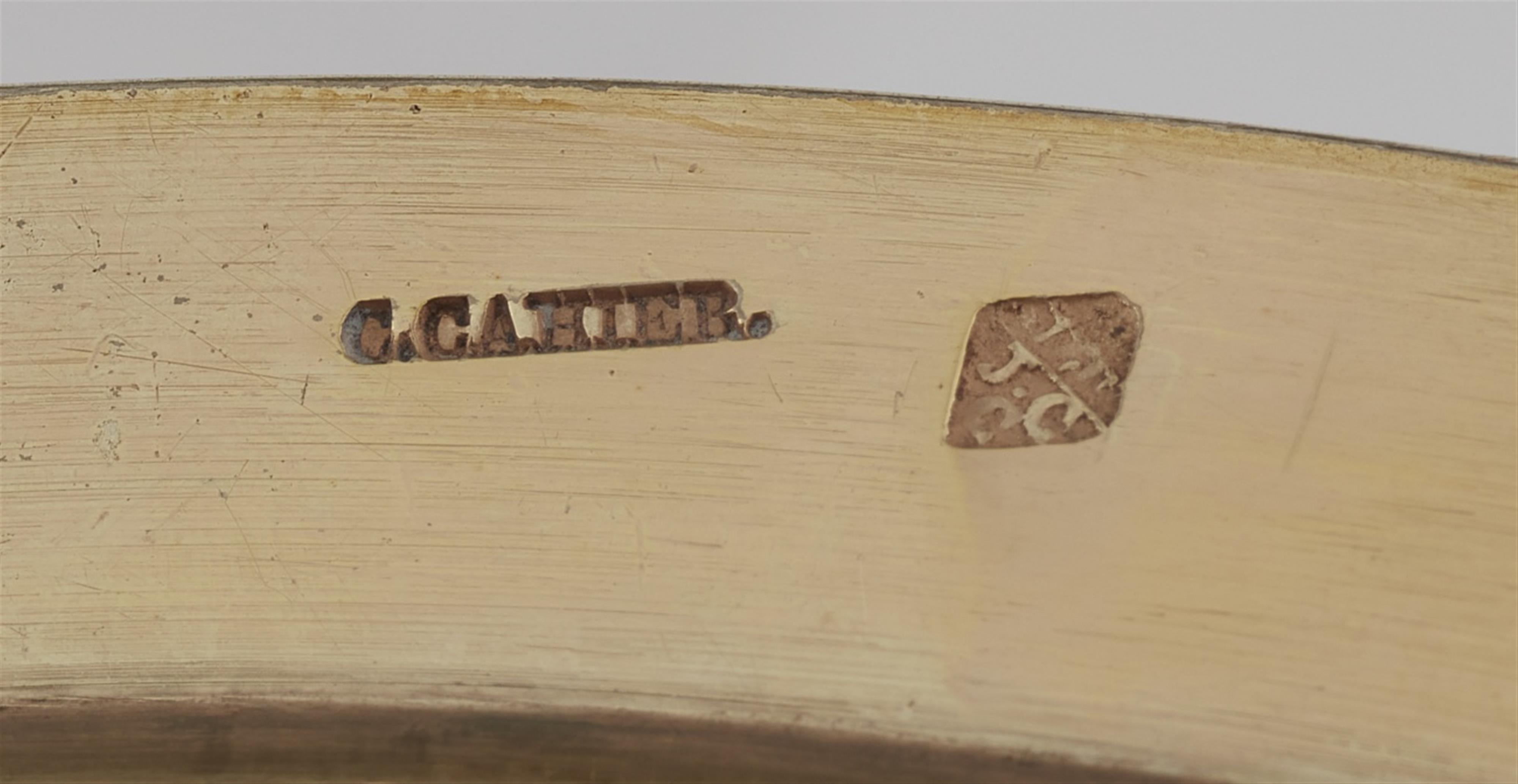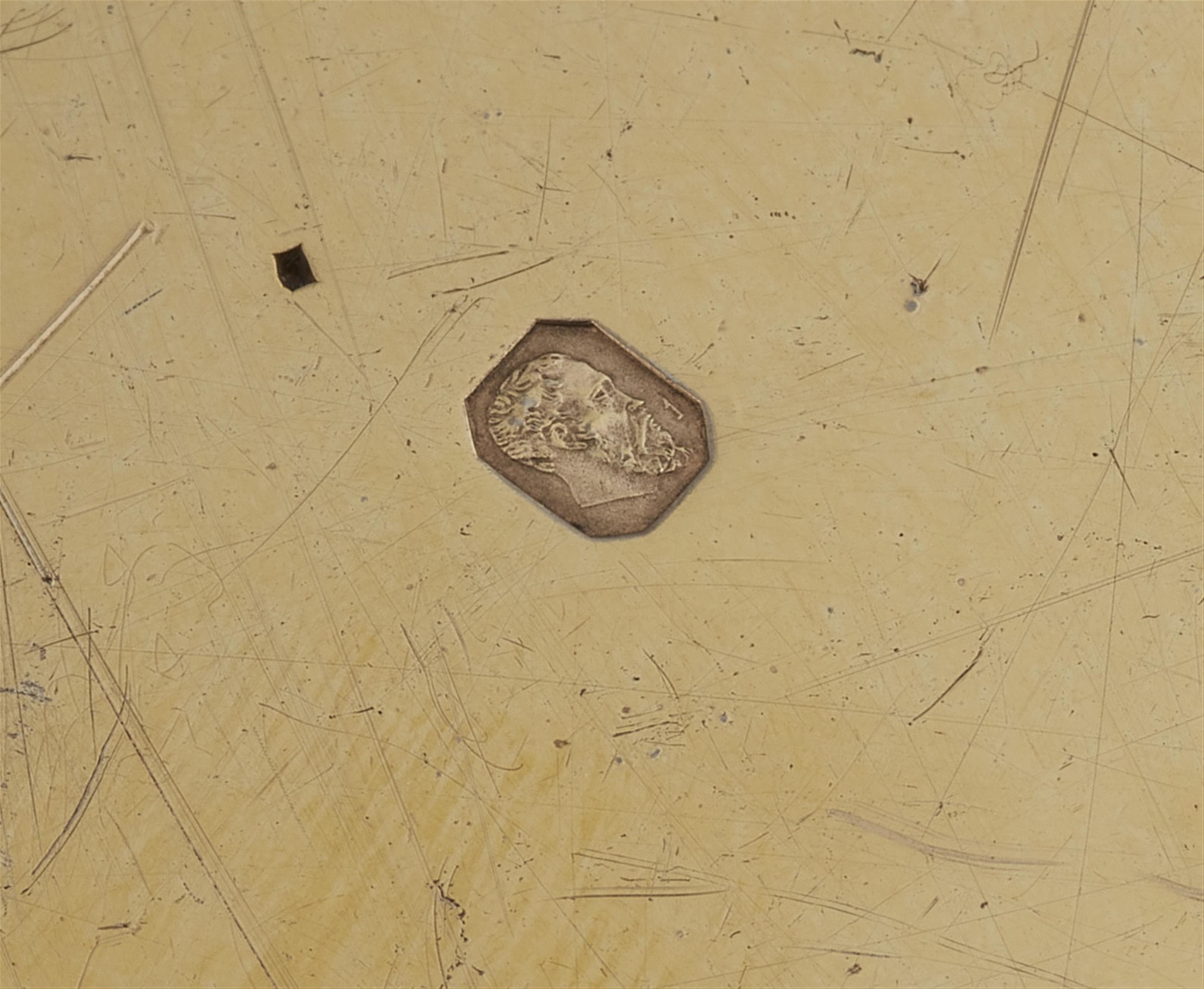Ten silver gilt plates from a service made for Grand Duke Michael Pavlovich
Slightly recessed plates with smooth wells. The broad lips engraved with the Cyrillic monogram “MP” beneath the Russian Tzar's crown, the rims with bands of stiff foliage. Diameter 24 cm, total weight 5,295 g.
Paris, marks of Jean-Charles Cahier, circa 1825 - 30.
Michael Pavlovich (1798 - 1849) was born as the youngest of ten children of Tzar Paul I and his second wife Princess Sophie Dorothee of Württemberg - and thus held the rank of a Russian Grand Duke. On February 19th 1824, he married his cousin Princess Charlotte of Württemberg, called Helena Pavlovna, in St. Petersburg. Michael's brother Alexander I, who had succeeded his father to the Tzar's throne in 1801, entrusted him with the then unimaginable sum of ten million rubles for the construction of a new Neoclassical palace on Arts Square in St. Petersburg. The Mikhailovsky Palace, which today houses the Russian Museum, was built from 1819 - 25 according to the plans of the architect Carlo Rossi and furnished by the Grand Duke and the Princess in the most sumptuous manner. Its legendary furnishings included a magnificent dinner service comprising over 1,200 pieces commissioned from the most important Parisian goldsmiths of the era: Martin-Guilleaume Biennais, Jean-Baptiste-Claude Odiot and Jean-Charles Cahier, who were engaged for several years in delivering the service to Mikhailovsky Palace. Large parts of the service have survived and are now housed in the collections of the Hermitage and in the silver chamber of the Kremlin in Moscow. Between the two world wars, however, individual pieces and entire sets were repeatedly sold and found their way into important private collections and major international museums.
Jean-Charles Cahier was one of the most important French silversmiths of the 19th century. After training under Napoleon's court goldsmith Martin-Guilleaume Biennais, he passed his master's examination in 1802 and soon received commissions from the French court himself. In 1821, he finally took over Biennais' workshop and held the title of court goldsmith to Kings Louis XVIII and Charles X. In addition to his work for the European aristocracy, such as the famous service for Michael Pavlovich, he also carried out important ecclesiastical commissions; his most famous opus is probably the reliquary of the Crown of Thorns in the silver chamber of Notre Dame de Paris, commissioned by Napoleon in 1806 and designed by Eugène Viollet-le-Duc.
Десять тарелок из сервиза для великого князя Михаила Павловича
Серебро; позолота. Слегка углубленные тарелки с плоским зеркальным дном. Широкая выгравированная кириллическая монограмма MП под короной русского царя; по краю стрельчатый фриз. Метки: парижская гарантия пробы 950 (1819 - 38), клеймо мастерской Jean-Charles Cahier (1797 - 1849, Rosenberg № 6578, 6592, Beuque № 2747). Диаметр 24 см, общий вес 5.295 г.
Париж, Жан-Шарль Кайе, ок. 1825 - 30.
Великий князь Михаил Павлович (1798 - 1849) был младшим из десяти детей русского царя Павла I и его второй жены принцессы Софии Доротеи Вюртембергской. 19 февраля 1824 года Михаил Павлович женился в Санкт-Петербурге на своей кузине принцессе Шарлотте Вюртембергской, названной Еленой Павловной. Брат Михаила, Александр I, сменивший отца на царском престоле в 1801 году, оставил ему немыслимую по тем временам сумму в десять миллионов рублей на строительство нового дворца в классическом стиле на Площади Искусств в Санкт-Петербурге. Михайловский дворец, в котором сегодня находится Русский музей, был построен в 1819 - 25 годах по планам архитектора Карло Росси. Легендарное убранство дворца включало великолепный столовый сервиз из более чем 1200 предметов, заказанный у самых известных парижских ювелиров: Мартен-Гийом Бьенне, Жан-Батист-Клод Одио и Жан-Шарль Кае в течение нескольких лет занимались его изготовлением и поставкой в Михайловский дворец. Значительная часть сервиза сохранилась и сейчас находится в коллекциях Эрмитажа или в серебряной палате Московского Кремля. В период между двумя мировыми войнами отдельные предметы и целые наборы временами выставлялись на продажу, попадали в важные частные коллекции и в известные международные музеи.
Жан-Шарль Кайе – один из самых значительных французских серебряных дел мастеров XIX века. После ученичества у придворного наполеоновского ювелира Мартина-Гийома Бьенне он сдал экзамен на звание мастера в 1802 году и вскоре сам стал получать заказы от французского двора. В 1821 году он окончательно возглавил мастерскую Бьенне и стал придворным ювелиром королей Людовика XVIII и Карла X. Помимо работ для европейской аристократии, таких как знаменитый сервиз для Михаила Павловича, он также выполнял важные церковные заказы; его самой известной работой, вероятно, является реликварий "Терновый венец" в серебряной палате Нотр-Дам де Пари, заказанный Наполеоном в 1806 году и спроектированный Эженом Виоле-ле-Дюком.
Оценочная стоимость: € 15.000 - 20.000
Литература
О Кайе см. Frégnac, Les Grand Orfèvres de Louis XIII à Charles X, Lausanne 1965, с. 310 и далее, а также
Tenenbaum, Orfèvrerie française du XIXe siècle. La collection du musée du Louvre, Paris 2011, с. 271 и далее.
Literature
On Cahier cf. Frégnac, Les Grand Orfèvres de Louis XIII à Charles X, Lausanne 1965, p. 310 f., and Tenenbaum, Orfèvrerie française du XIXe siècle. La collection du musée du Louvre, Paris 2011, p. 271f.

